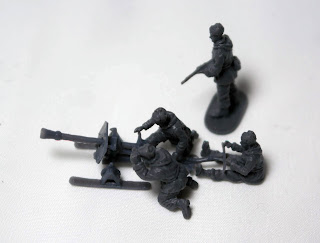The Caesar 21cm Nebelwerfer 42 kit comes with an interesting little model of the 8.8cm Raketenwerfer 43 (which is not shown on the box art).
I could not find any real life pictures of a Raketenwerfer with skis like in the kit, but there are many toys and models of this specific type of rocket launcher.
 |
| Raketenwerfer without wheels (or skis). |
This anti-tank weapon fired an 8.8cm fin stabilized rocket propelled HEAT grenade, and supposedly had such excellent performance that the OKH disallowed awarding a Tank Destruction Badge if it was used to successfully knock out a tank.
 |
| Raketen Panzer Granat 4312 |
The model has just seven pieces, and could be considered a very easy build except for one small issue – the model is made from polyethylene which is almost impossible to glue together.
There are a couple of methods for gluing polyethylene parts together. One method involves heat treating the plastic with a blowtorch, which I don't think will work for plastic models. The other is to treat the parts with a primer which will create a surface that CA glue will bond with.
The most commonly available glue for polyethylene is the Loctite Plastics Bonding System, which uses the priming method. The problem with this product however, is that the activator is applied with a pen-like applicator, which does not work well with small parts.
The activator can be purchased separately in liquid form as Loctite 770, but it costs about $10 an oz.
I dipped the parts in Bestine, shook off the excess onto a disposable paper towel, and allowed the parts to dry for a minimum of 1 minute. After that, I just applied glue, and assembled the parts in the usual manner.
A test bond that I did with some pieces of the sprue from the model held with Bestine treatment, but the bond didn't have much strength. The control with no Bestine treatment didn't bond at all.
I wanted to make the test with the glue from the Plastics Bonding System, but my glue was all dried up, so I had to make do with Loctite Professional Liquid instead. I'm not sure if this made a difference, so maybe I'll do some more tests in the future.
The model itself seems to be holding up okay with normal handling, though I'm not sure how well it would fare with being used for gaming.
Important: If you plan on using Bestine or n-Heptane, Read the MSDS, be sure to work in a well ventilated area, and follow all safety procedures for handling dangerous chemicals. Heptane is flammable, a skin irritant, and potentially toxic if inhaled or ingested.


























RETRACTION
ReplyDeletePlease ignore everything I said about using Heptane as a primer. I finally found the technical data sheet for Loctite 770, and it seems that it is actually an aliphatic amine suspended in Heptane that is the active ingredient.
I think that the Heptane treatment I did probably just cleaned off the mold release from the parts allowing the glue to work a little better than without cleaning.
I don't think a retraction was necessary! Surly the heptane as well as a carrier is the active ingredient in the old Plastix activator pen, helping the super-glue penetrate the molecular structure of the polymer? I'm guessing . . . can you tell!
ReplyDeleteH
I have had success in the past with polythene using "Evostick" or similar petroleum based contact adhesive. It is not perfect, but by the time that paint has gone on, it seems more than strong enough. A coating of PVA adhesive helps in this respect too.
ReplyDeleteKind regards,
Chris
Hi Chris,
ReplyDeleteThanks for the tip. I wasn't familiar with Evostick, but I guess PVA makes sense since people use it to prime polyethylene figures for painting.